2021 Vegetable IPM Program Personnel
Kris Holmstrom and Joe Ingerson-Mahar would like to acknowledge the IPM Field Technicians for this season:
Rhea Bolar
Claire Chapeau
Jeff Kane
Jake Newcombe
Gabriel Torres
Without the assistance of these individuals, much of the information presented in this publication would be unobtainable. We are grateful for all their help and hard work.
Sweet Corn
Low numbers of European corn borer (ECB) moths continue to be captured in parts of the state. Hot weather over the past week has not increased catches, indicating that this initial flight may be nearing its’ end. The highest adult activity is currently Gloucester and western Burlington counties (see map at right). Whorl corn is the primary target for egg laying, and injury as high as 18% of plants infested has been found in Hunterdon County this week. It is typical for feeding percentages to rise as the moth catch declines. We expect feeding to increase for the next 1-2 weeks before peaking.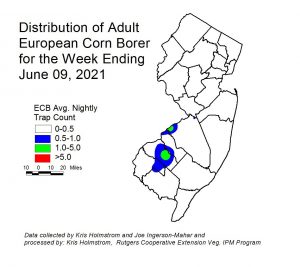
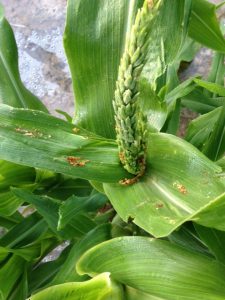 Look for the characteristic “shot-hole” type of feeding (photo below at right) and consider treating when infested plants exceed 12% in a 50 plant sample. As plantings proceed to the pre-tassel stage, ECB larvae may be found in emerging tassels (see photo at left). It is a good idea to treat individual plantings as they move into the full tassel/first silk stage one time. This eliminates any ECB larvae that have emerged with the tassels as they begin to move down the stalk to re-enter near developing ears.
Look for the characteristic “shot-hole” type of feeding (photo below at right) and consider treating when infested plants exceed 12% in a 50 plant sample. As plantings proceed to the pre-tassel stage, ECB larvae may be found in emerging tassels (see photo at left). It is a good idea to treat individual plantings as they move into the full tassel/first silk stage one time. This eliminates any ECB larvae that have emerged with the tassels as they begin to move down the stalk to re-enter near developing ears.
Useful insecticides for this particular application include synthetic 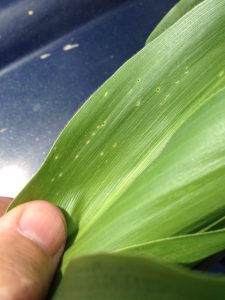 pyrethroids (IRAC Grp 3), spinosyns (including OMRI approved Entrust) IRAC Grp 5), and diamides such as Coragen or Vantacor (IRAC Grp 28) or materials such as Besiege which include the active ingredient in Coragen. Synthetic pyrethroids alone should NOT be used for corn earworm (CEW) protection on silking corn. Control with these materials is very inconsistent.
pyrethroids (IRAC Grp 3), spinosyns (including OMRI approved Entrust) IRAC Grp 5), and diamides such as Coragen or Vantacor (IRAC Grp 28) or materials such as Besiege which include the active ingredient in Coragen. Synthetic pyrethroids alone should NOT be used for corn earworm (CEW) protection on silking corn. Control with these materials is very inconsistent.
The highest nightly trap catches of ECB for the week ending 6/09/21 are as follows:
| Cinnaminson 2 | Centerton 1 | Green Creek 1 |
| Downer 2 | Crosswicks 1 | Milford 1 |
| Asbury 1 | East Vineland 1 | Oldwick 1 |
| Califon 1 | Eldora 1 | Sergeantsville 1 |
Corn earworm (CEW) moths captures from blacklight traps remain exceedingly low. However, pheromone trap captures in the southern counties have been somewhat higher. These limited catches indicate that a low but economically significant population continues in these areas. The earliest plantings, now in silk, are at risk of CEW infestation. Be sure to access information from this publication in the upcoming weeks to determine how frequently you must treat silking sweet corn to protect it from CEW infestation. As more pheromone traps are deployed, maps for that trap type will appear in this publication.
The highest nightly blacklight trap catches of CEW for the week ending 6/09/21 are as follows:
| Long Valley 1 |
| Matawan 1 |
| Morristown 1 |
The highest nightly pheromone trap catches of CEW for the week ending 6/09/21 are as follows:
| Monroeville 46 |
| Woodstown 15 |
| Beckett 12 |
Silking Spray Schedules*:
South – 4 days
Central – 6-7 days
North – 6-7 days
*These recommendations are based on regional catches. Adhere to tighter spray schedules if indicated by local trap catches. Synthetic pyrethroids alone should NOT be used for corn earworm (CEW) protection on silking corn, or for fall armyworm (FAW) management at any stage. Control with these materials is very inconsistent.
Cole Crops
Increasing numbers of imported cabbage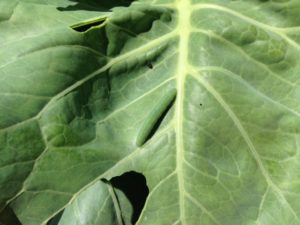 worm (ICW at left) continue in cole crop plantings everywhere. With warmer temperatures here, these infestations will increase and continue for the duration of the growing season. Check 5 consecutive plants each in 10 random locations throughout the planting, paying particular attention to the innermost leaves where ICW often feed (see photo at lower right). Consider treating if caterpillars are found on 10% or more plants that are in the 0-9 true leaf stage. From 9-leaf to the early head stage (in broccoli, cauliflower, and cabbage) infestations up to 20% may be tolerated. Once heads begin to form, a 5% threshold should be observed to protect the marketable portion of
worm (ICW at left) continue in cole crop plantings everywhere. With warmer temperatures here, these infestations will increase and continue for the duration of the growing season. Check 5 consecutive plants each in 10 random locations throughout the planting, paying particular attention to the innermost leaves where ICW often feed (see photo at lower right). Consider treating if caterpillars are found on 10% or more plants that are in the 0-9 true leaf stage. From 9-leaf to the early head stage (in broccoli, cauliflower, and cabbage) infestations up to 20% may be tolerated. Once heads begin to form, a 5% threshold should be observed to protect the marketable portion of 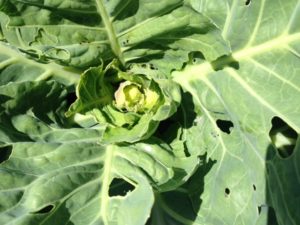 the plant. For leafy greens such as collards and kale, 10% plants infested is the threshold throughout.
the plant. For leafy greens such as collards and kale, 10% plants infested is the threshold throughout.
Diamondback moth larvae (DBM) are now the dominant pest in a number of scouted plantings. Remember that some populations of DBM are resistant to carbamate and synthetic pyrethroid insecticides. The lack of DBM control with these insecticides has been noted in NJ previously. It is important to distinguish between common cole crop pests for this reason. DBM larvae grow to a length of approximately 0.5”, and taper toward both ends (see photo at lower right).  These caterpillars thrash violently when disturbed. ICW grow to a length of approximately 1.25” and are covered with short hairs. Some chemistries that specifically target caterpillar pests are effective against DBM as well as all other caterpillar pests of cole crops. These materials include (active ingredient – trade name (IRAC* code)):
These caterpillars thrash violently when disturbed. ICW grow to a length of approximately 1.25” and are covered with short hairs. Some chemistries that specifically target caterpillar pests are effective against DBM as well as all other caterpillar pests of cole crops. These materials include (active ingredient – trade name (IRAC* code)):
Spinosad/Spinetoram – Entrust/ Radiant (5)
Chlorantraniliprole – Coragen (28)
Cyantraniliprole – Exirel (28)
The IRAC group 5 insecticide, Entrust, is OMRI approved for organic production. Insecticides based on the soil-inhabiting bacterium Bacilllus thuringiensis (B.t.) may also be effective on caterpillar pests of cole crops. Examples include Xentari and Javelin.
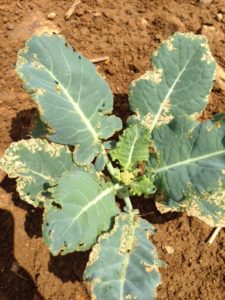 Flea beetles are a consistent problem in a number of plantings. Signs of “shot-hole” in leaves of host crops are an indication that flea beetles are present, even if the pests are not visible due to cold/wet weather. These pests have a preference for the “hotter” flavored crops like arugula, mustard greens, and turnip greens. They also attack Tuscan or lacinato kale frequently. Plants may be protected with at-planting, soil-applied neo-nicotinoid insecticides (see the 2020/21 Commercial Vegetable Production Recommendations for products). An OMRI approved foliar material for flea beetle management is Pyganic. This product will provide knock-down of flea beetles, but may need to be applied frequently on preferred host crops.
Flea beetles are a consistent problem in a number of plantings. Signs of “shot-hole” in leaves of host crops are an indication that flea beetles are present, even if the pests are not visible due to cold/wet weather. These pests have a preference for the “hotter” flavored crops like arugula, mustard greens, and turnip greens. They also attack Tuscan or lacinato kale frequently. Plants may be protected with at-planting, soil-applied neo-nicotinoid insecticides (see the 2020/21 Commercial Vegetable Production Recommendations for products). An OMRI approved foliar material for flea beetle management is Pyganic. This product will provide knock-down of flea beetles, but may need to be applied frequently on preferred host crops.
Tomatoes
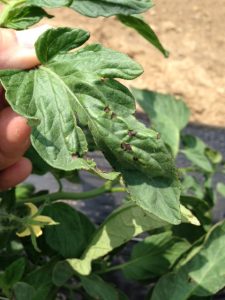 Bacterial leaf spot (BLS) symptoms have begun to appear in a few northern NJ tomato fields. Symptoms of this infection include small, very dark lesions appearing on foliage of any age (see photo at left). Often even immature, unexpanded leaves are affected. Copper resistance in BLS populations in NJ has been identified. Please refer to Dr. Andy Wyenandt’s post of 5/28 regarding bacterial leaf spot of tomatoes and peppers for further information on this important disease of these crops.
Bacterial leaf spot (BLS) symptoms have begun to appear in a few northern NJ tomato fields. Symptoms of this infection include small, very dark lesions appearing on foliage of any age (see photo at left). Often even immature, unexpanded leaves are affected. Copper resistance in BLS populations in NJ has been identified. Please refer to Dr. Andy Wyenandt’s post of 5/28 regarding bacterial leaf spot of tomatoes and peppers for further information on this important disease of these crops.
Peppers
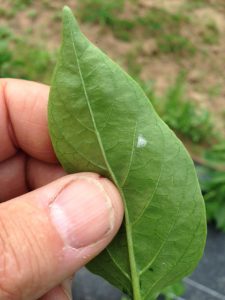 With ECB moth activity continuing, growers should be looking for ECB egg masses (see photo at left) on the underside of pepper leaves. The larvae that hatch from these eggs will bore into the central stem of pepper plants in the absence of suitable fruit. This damage causes the tops of the plant to die, and eliminating the crown set of fruit in the process. Check 2 leaves per plant on 5 consecutive plants in 10 random locations. Consider treating if 2 or more leaves are found to have ECB larvae on the lower surface.
With ECB moth activity continuing, growers should be looking for ECB egg masses (see photo at left) on the underside of pepper leaves. The larvae that hatch from these eggs will bore into the central stem of pepper plants in the absence of suitable fruit. This damage causes the tops of the plant to die, and eliminating the crown set of fruit in the process. Check 2 leaves per plant on 5 consecutive plants in 10 random locations. Consider treating if 2 or more leaves are found to have ECB larvae on the lower surface.
Pepper weevil – Pheromone traps continue to be set out across southern New Jersey. As yet, no weevils have been trapped. A new fact sheet is now available for anyone interested in monitoring for pepper weevils on their own: FS1330: Monitoring and Management of Pepper Weevil in New Jersey (Rutgers NJAES).
Potato Leafhopper
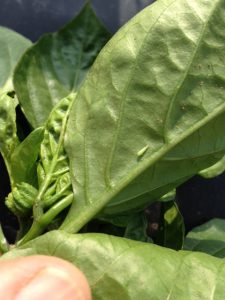 Potato leafhopper (PLH) adults (see photo at left) have appeared in snap beans and other crops over the past week. This pest is a particular problem because it often goes unnoticed until foliar distortion and burn occurs. Once this damage appears in beans and some potato varieties, yields have already been compromised. It is critical that beans be monitored regularly for the presence of PLH. If a sweep net is available, consider treating if more than 100 nymphs and adults are present in 20 sweeps of pre-bloom stage plants. This threshold increases to 250 during bloom and to 500 per 20 sweeps during pod development. If no sweep net is available, check plants in 10 random field locations and consider treating if adults and nymphs are found throughout. Adults are pale green, and will fly out from foliage when disturbed and immediately fly back into the plant canopy. Nymphs are wingless and bright green and may be found on the underside of leaves.
Potato leafhopper (PLH) adults (see photo at left) have appeared in snap beans and other crops over the past week. This pest is a particular problem because it often goes unnoticed until foliar distortion and burn occurs. Once this damage appears in beans and some potato varieties, yields have already been compromised. It is critical that beans be monitored regularly for the presence of PLH. If a sweep net is available, consider treating if more than 100 nymphs and adults are present in 20 sweeps of pre-bloom stage plants. This threshold increases to 250 during bloom and to 500 per 20 sweeps during pod development. If no sweep net is available, check plants in 10 random field locations and consider treating if adults and nymphs are found throughout. Adults are pale green, and will fly out from foliage when disturbed and immediately fly back into the plant canopy. Nymphs are wingless and bright green and may be found on the underside of leaves.
Cucurbit Downy Mildew
A cucurbit downy mildew sentinel plot is now established at Snyder Farm in Hunterdon County. This plot, consisting of pumpkin, watermelon, cantaloupe, butternut, acorn, cucumber and kabocha squash will be used to indicate the presence of cucurbit downy mildew in the region, and what crops are affected. For regional information on this important disease, see the Cucurbit Downy Mildew Forecast webpage: http://cdm.ipmpipe.org/.
Brown marmorated stink bug (BMSB)
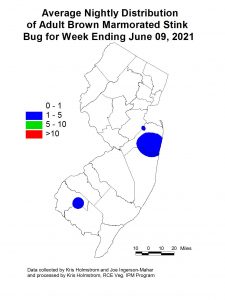 Blacklight trap catches of BMSB have increased from nearly nothing a week ago to low but consistent numbers in a few parts of the state (see map at left). It is likely that these trap catches reflect the activity of the bugs themselves in any given area. We often see numbers increase dramatically during heat waves like the one we are now experiencing. While this pest has generally declined as a threat to peppers, it remains a significant threat to tree fruit.
Blacklight trap catches of BMSB have increased from nearly nothing a week ago to low but consistent numbers in a few parts of the state (see map at left). It is likely that these trap catches reflect the activity of the bugs themselves in any given area. We often see numbers increase dramatically during heat waves like the one we are now experiencing. While this pest has generally declined as a threat to peppers, it remains a significant threat to tree fruit.
The highest nightly catches of BMSB in black light traps for the week ending 6/09/21 are as follows:
| Farmingdale 4 | Matawan 2 |
| Centerton 3 | Old Bridge 2 |
| Allentown 2 | Oldwick 1 |
| Georgetown 2 | Princeton 1 |

